Content for TS 23.281 Word version: 19.2.0
1…
5…
6…
7…
7.1.2.3…
7.1.2.3.1.2…
7.1.2.3.2…
7.1.2.4…
7.1.2.5.2…
7.1.3…
7.2…
7.2.2.3…
7.2.2.4…
7.2.3…
7.3…
7.4…
7.4.3…
7.5…
7.5.2.3…
7.6…
7.7…
7.7.1.3…
7.7.1.3.2A…
7.7.1.3.4…
7.7.1.3.6…
7.7.2…
7.7.2.7…
7.7.2.9…
7.8…
7.11…
7.17…
7.19…
7.19.2.8…
7.19.3…
7.19.3.1.4…
7.19.3.2…
7.19.3.2.3…
7.19.3.2.6…
A…
7.7.1.3.2A End media reception - receiving user initiated
7.7.1.3.2B End media reception - transmission control server initiated
7.7.1.3.2C Reception control on overridden - mandatory mode
7.7.1.3.2D Reception control on overridden - negotiated mode
7.7.1.3.3 Transmission revoke during an MCVideo session
...
...
7.7.1.3.2A End media reception - receiving user initiated p. 137
Figure 7.7.1.3.2A-1 describes the procedure for the receiving user initiated media reception end. Only two UEs involved in the session are shown for the simplicity.
Pre-condition:
- MCVideo session is established between MCVideo clients (client A and client B) and MCVideo server
- Transmission control is established between transmission control participants and transmission control server.
- Transmission control participant A has been granted the permission to transmit media.
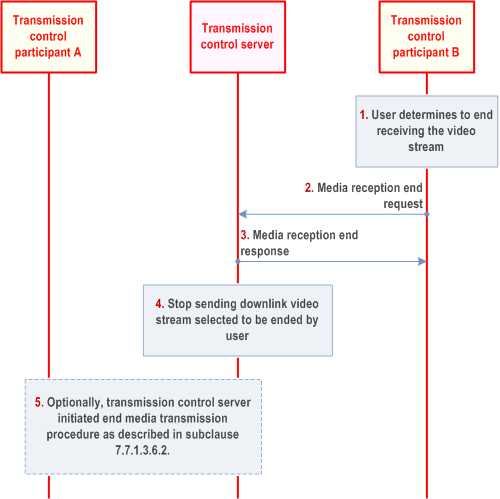
Step 1.
The MCVideo user determines to end a receiving video stream.
Step 2.
The user sends an media reception end request including the video stream to be ended to the transmission control server.
Step 3.
The transmission control server returns a media reception end response.
Step 4.
Upon receiving the media reception end request, the transmission control server stops sending the video stream selected to the transmission control participant B.
Step 5.
If the end media reception at transmission control participant B causes the video transmission continuation condition to fail, then the transmission control server initiates the media transmission end procedure as described in subclause 7.7.1.3.6.2.
7.7.1.3.2B End media reception - transmission control server initiated p. 138
Figure 7.7.1.3.2B-1 describes the procedure for the transmission control server initiated media reception end. Only two UEs involved in the session are shown for the simplicity.
Pre-condition:
- MCVideo session is established between MCVideo clients (client A and client B) and MCVideo server
- Transmission control is established between transmission control participants and transmission control server.
- Transmission control participant A has been granted the permission to transmit media.
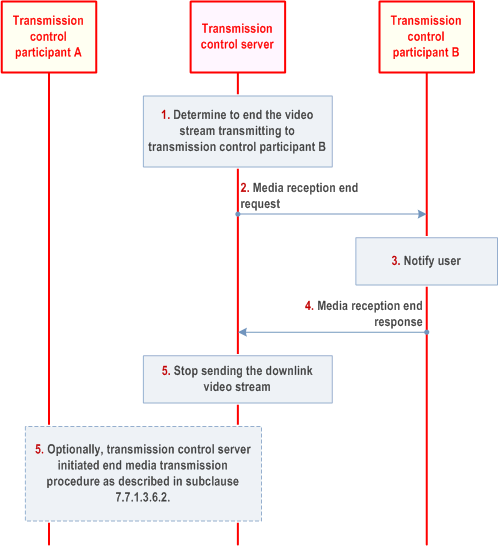
Step 1.
The transmission control server determines to end a video stream transmitting to transmission control participant B according to events or configurations.
Step 2.
The transmission control server sends an media reception end request including the video stream to be ended to the transmission control participant B.
Step 3.
The MCVideo user is notified about the media reception end.
Step 4.
The transmission control participants B returns a media reception end response.
Step 5.
The transmission control server stops sending the video stream selected to the transmission control participant B.
Step 6.
If the end media reception at transmission control participants B causes the continuation conditions to fail, then the transmission control server initiates media transmission end procedure as described in subclause 7.7.1.3.6.2.
7.7.1.3.2C Reception control on overridden - mandatory mode p. 139
Figure 7.7.1.3.2C-1 describes the procedure for the reception control on overridden with mandatory mode that the transmission control server determines the video stream to be overridden. Only two UEs involved in the session are shown for the simplicity.
Pre-condition:
- MCVideo session is established between MCVideo clients (client A and client B) and MCVideo server.
- Transmission control is established between transmission control participants and transmission control server.
- Transmission control participant A has been granted the permission to transmit media.
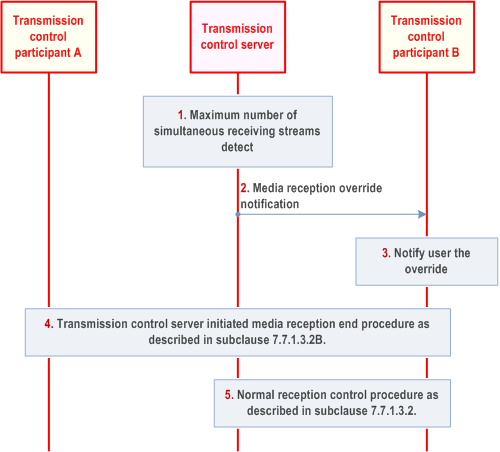
Step 1.
A new media stream is to be delivered to the transmission control participant B while the maximum number of simultaneous streams is reached. The transmission control server determines to override another media stream being received by the transmission control participant B accord to the media stream characteristics.
Step 2.
Transmission control server sends a media reception override notification message to the transmission control participant B including information about the video stream being overridden and stop the downlink delivery of the overridden video stream to the transmission control participant B. The overriding video stream information maybe also included.
Step 3.
The user of UE B is notified about the details of overriding/overridden.
Step 4.
The transmission control server initiates the media reception end procedure as described in subclause 7.7.1.3.2B.
Step 5.
The transmission control server performs the normal reception control procedure as described in subclause 7.7.1.3.2.
7.7.1.3.2D Reception control on overridden - negotiated mode p. 139
Figure 7.7.1.3.2D-1 describes the procedure for the reception control on overridden with negotiated mode that the transmission control participant determines the video stream to be overridden. Only two UEs involved in the session are shown for the simplicity.
Pre-condition:
- MCVideo session is established between MCVideo clients (client A and client B) and MCVideo server
- Transmission control is established between transmission control participants and transmission control server.
- Transmission control participant A has been granted the permission to transmit media.
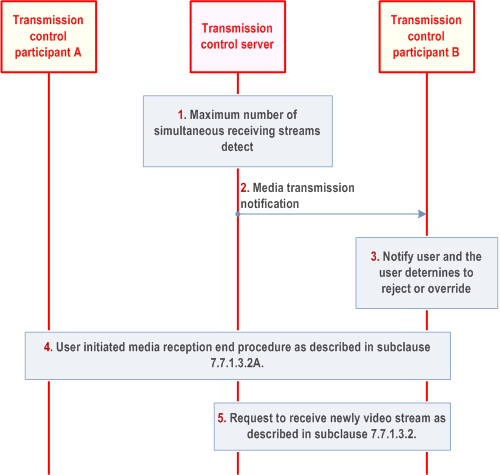
Step 1.
A new media stream is to be delivered to the transmission control participant B while the maximum number of simultaneous streams is received. The transmission control server determines to override another media stream being received by the transmission control participant B according to the media stream characteristics.
Step 2.
Transmission control server sends a media transmission notification message to the transmission control participant B including information about the new video stream.
Step 3.
The user of transmission control participant B is notified about the maximum number of simultaneous streams received. The MCVideo user determines to reject the video stream or accept the video streaming by overriding a receiving video stream.
Step 4.
The transmission control participant initiates the media reception end procedure as described in subclause 7.7.1.3.2A.
Step 5.
Then the transmission control participant B requests to receive the new video stream as the normal reception control procedure described in subclause 7.7.1.3.2.
7.7.1.3.3 Transmission revoke during an MCVideo session p. 140
Figure 7.7.1.3.3-1 describes the procedure for transmission revoke during an MCVideo session. Only two UEs involved in the session are shown for the simplicity.
Pre-condition:
- MCVideo session is established between MCVideo clients (client A and client B) and MCVideo server
- Transmission control is established between transmission control participants and transmission control server.
- Transmission control participant B has been granted the permission to transmit media and there may be ongoing media transmission from transmission control participant B.
- The maximum media transmission limit for the MCVideo session is reached.
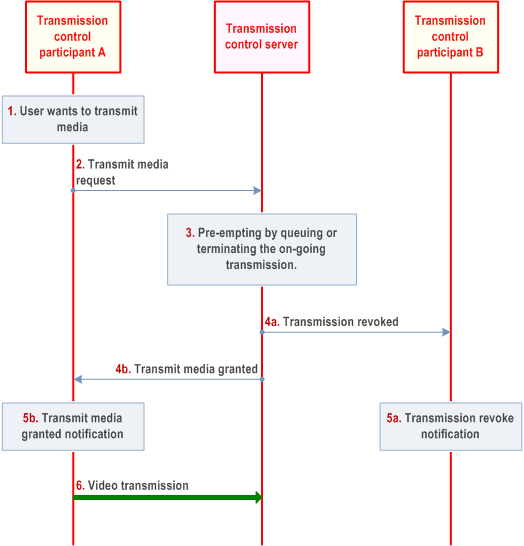
Step 1.
Transmission control participant A wants to send video media over the session.
Step 2.
Transmission control participant A sends a transmit media request message to transmission control server which includes transmission priority and other information as necessary.
Step 3.
Transmission control server determines to accept the transmit media request from transmission control participant A and decides to pre-empt the on-going video transmission from transmission control participant B by queuing or ending the on-going video transmission.
Step 4.
Transmission control server responds with a transmission revoked message (4a) to transmission control participant B with the action of pre-emption whether queued or terminated. Transmission control server responds with a transmit media granted message (4b) to transmission control participant A.
Step 5.
The transmission revoked shall cause the transmission control participant B to be notified of the revoke (5a) of the on-going video transmission by queuing or termination. The transmit media granted shall cause the user of UE A where the transmission control participant A is located to be notified.
Step 6.
Transmission control participant A starts sending video media over the session established to the transmission control server.